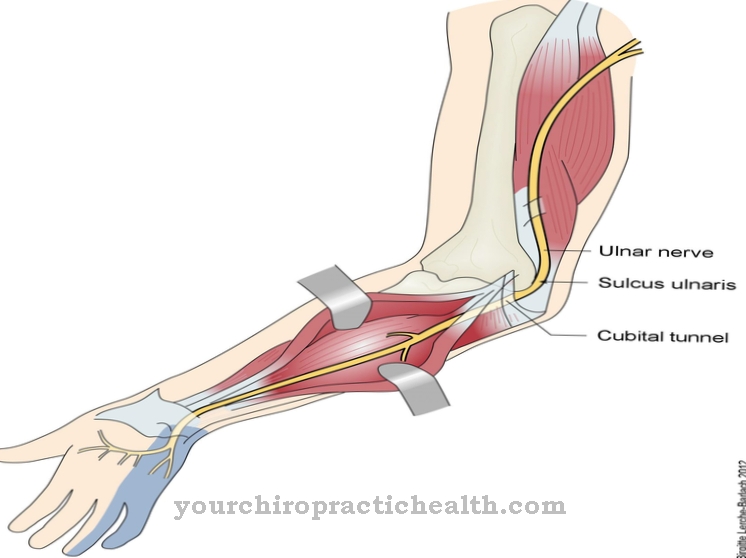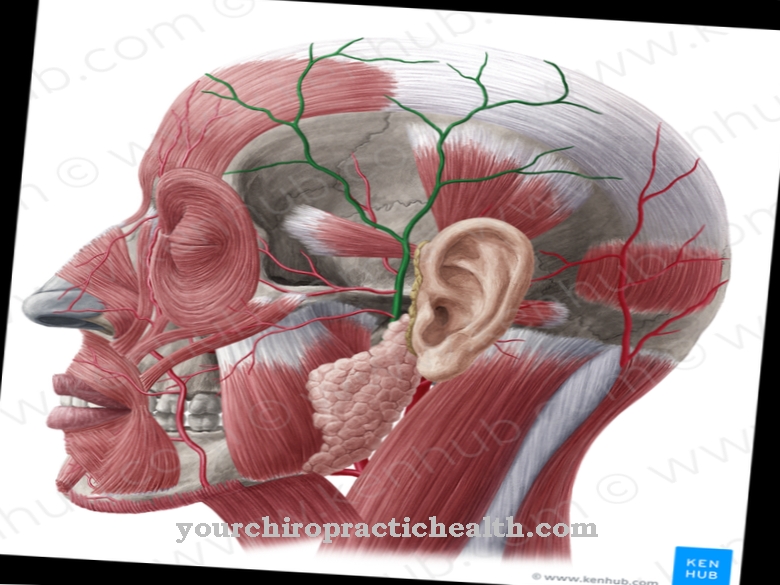The Submandibular gland, also Mandibular salivary gland called, belongs to the three major salivary glands. It is created in pairs at the lower jaw angle. Their ducts open into the oral cavity on the left and right of the tongue frenulum.
What is submandibular gland?
Together with the parotid gland (Glandula parotidea) and the sublingual gland (Glandula sublingualis), the Glandula submandibularis is one of the three large salivary glands. It is a seromucosal gland, which means that the secretions of the sublingual salivary gland contain both serum-like (serous) and mucous (mucous) components. Most of the saliva comes from the submandibular gland.
Anatomy & structure
The submandibular gland is located in the floor of the mouth on the inside of the lower jaw. More precisely, it lies exactly between the lower jaw and the digastric muscle, a head muscle. The lower jaw and the digastric muscle form the so-called submandibular trigonum at this point. The gland is embedded here in the superficial sheet of the neck fascia (fascia cervicalis or also fascia colli).
The posterior part of the mandibular salivary gland encompasses the posterior border of the hyoid bone muscle (mylohyoid muscle). The excretory duct of the gland, the submandibular duct or Wharton's duct, as well as the sublingual salivary gland, open below the tongue. The exact location is on the side of the tongue ligament on the starvation wart (caruncula sublingualis).
The submandibular gland belongs to the mixed seromucosal salivary glands. It has a tubuloazine structure. Tubuloacous glands can be recognized by their branched tubular system of gland ducts. The gland ducts end in berry-shaped end pieces, the acini. Serous acini predominate in the submandibular gland. Between these there are only a few mucous gland tubes. These produce the slimy part of the saliva.
The mandibular salivary gland is supplied parasympathetically by nerve cells from the nucleus salivatorius superior. The sympathetic nerve fibers run from the superior cervical ganglion to the salivary gland.
Function & tasks
The main function of the submandibular gland is to produce saliva. The parotid gland only produces serous saliva. This saliva is very fluid and watery and has no slimy additives. The secretion of the sublingual gland is predominantly mucous, i.e. slimy. The saliva produced by the submandibular gland is a mixture of both. It has both mucous and serous parts.
Every day, about 0.6 to 1.5 liters of saliva are produced in all three salivary glands in an adult human. The salivation, i.e. the production of saliva, depends on the amount of food supplied. Even without ingesting food, saliva is constantly produced. One speaks here of a basal secretion. This is around half a liter of saliva per day. The lower salivary gland produces most of the saliva.
Most of the saliva produced in the salivary glands consists of water in the mixture (99.5%). This water contains so-called mucins, proteins, digestive enzymes, antibodies and minerals. The mucins give the saliva of the submandibular gland its slimy shape. They protect the mucous membranes of the oral cavity from chemical and mechanical influences. In addition, they ensure the viscosity of the saliva and make the chyme more lubricious, so that it can more easily get through the esophagus into the stomach.
The ptyalin formed in the submandibular gland, also called alpha-amylase, is a digestive enzyme that is responsible for the pre-digestion of carbohydrates. The digestion of the chyme begins in the mouth due to the alpha-amylase contained in the saliva. Due to the substances it contains, such as immunoglobulins, lactoferrin or lysozyme, the saliva also has an antibacterial effect. In addition, without the saliva produced in the salivary glands, swallowing, speaking and tasting would not be possible at all. Smelling is also influenced by saliva.
You can find your medication here
➔ Medication for bad breath and bad breathDiseases
If too much saliva is produced in the salivary gland, one speaks of hypersalivation. Physiologically, this can be done by irritating the taste buds, the olfactory nerves, the gastric and intestinal nerves or the optic nerves. However, diseases of the salivary glands and the oral cavity as well as poisoning can result in increased salivation.
Dry mouth caused by too little saliva often occurs in old age. Radiation therapy or certain diseases such as Sjögren's syndrome can also cause dry mouth (xerostomia). Sjogren's syndrome is an autoimmune disease in which the immune system attacks the salivary glands, among other things. Almost 100% of all Sjogren's patients suffer from a dry mouth.
If the salivary gland is swollen and painful, there is usually an inflammation. The parotid gland is most commonly affected by inflammation, but the submandibular gland can also become inflamed. The most common cause of inflammation of the lower jaw salivary gland are infections with bacteria such as staphylococci or streptococci. The germs migrate through the ducts into the interior of the gland and cause a defense reaction there. This then shows up in the form of inflammation. The salivary gland is particularly sensitive to such inflammation when it produces little saliva. Therefore, salivary gland inflammation mostly affects older people. Poor oral hygiene, malnutrition or inflammation of the oral mucosa also promote inflammation of the salivary glands.
Salivary gland inflammation is often related to salivary stones. The submandibular gland is the salivary gland where most salivary stones arise. Eight out of ten salivary stones form here. These stones consist largely of magnesium and calcium phosphate. They can grow up to two inches tall. With salivary stones, the salivary gland swells. Potential pain worsens as saliva production, such as when chewing, increases. Inflammation of the salivary gland caused by salivary stones can result in an abscess. In the worst case this leads to blood poisoning.

























.jpg)

.jpg)
